The oculomotor system utilizes color extensively for planning saccades. Therefore, we examined how the oculomotor system actually encodes color and several factors that modulate these representations: attention-based surround suppression and inherent biases in selecting and encoding color categories. We measured saccade trajectories while human participants performed a memory-guided saccade task with color targets and distractors and examined whether oculomotor target selection processing was functionally related to the CIE (x,y) color space distances between color stimuli and whether there were hierarchical differences between color categories in the strength and speed of encoding potential saccade goals. We observed that saccade planning was modulated by the CIE (x,y) distances between stimuli thus demonstrating that color is encoded in perceptual color space by the oculomotor system. Furthermore, these representations were modulated by (1) cueing attention to a particular color thereby eliciting surround suppression in oculomotor color space and (2) inherent selection and encoding biases based on color category independent of cueing and perceptual discriminability. Since surround suppression emerges from recurrent feedback attenuation of sensory projections, observing oculomotor surround suppression suggested that oculomotor encoding of behavioral relevance results from integrating sensory and cognitive signals that are pre-attenuated based on task demands and that the oculomotor system therefore does not functionally contribute to this process. Second, although perceptual discriminability did partially account for oculomotor processing differences between color categories, we also observed preferential processing of the red color category across various behavioral metrics. This is consistent with numerous previous studies and could not be simply explained by perceptual discriminability. Since we utilized a memory-guided saccade task, this indicates that the biased processing of the red color category does not rely on sustained sensory input and must therefore involve cortical areas associated with the highest levels of visual processing involved in visual working memory.
